German Bread (Authentic Vollkornbrot)
This post may contain affiliate links. See my disclosure policy.
A thoroughly authentic German Bread Recipe (Vollkornbrot)! This delicious traditional German whole grain seed bread is nutrient dense with a fabulous texture and positively packed with flavor. This makes a large loaf that freezes well so you can conveniently grab some whenever you’re in the mood.
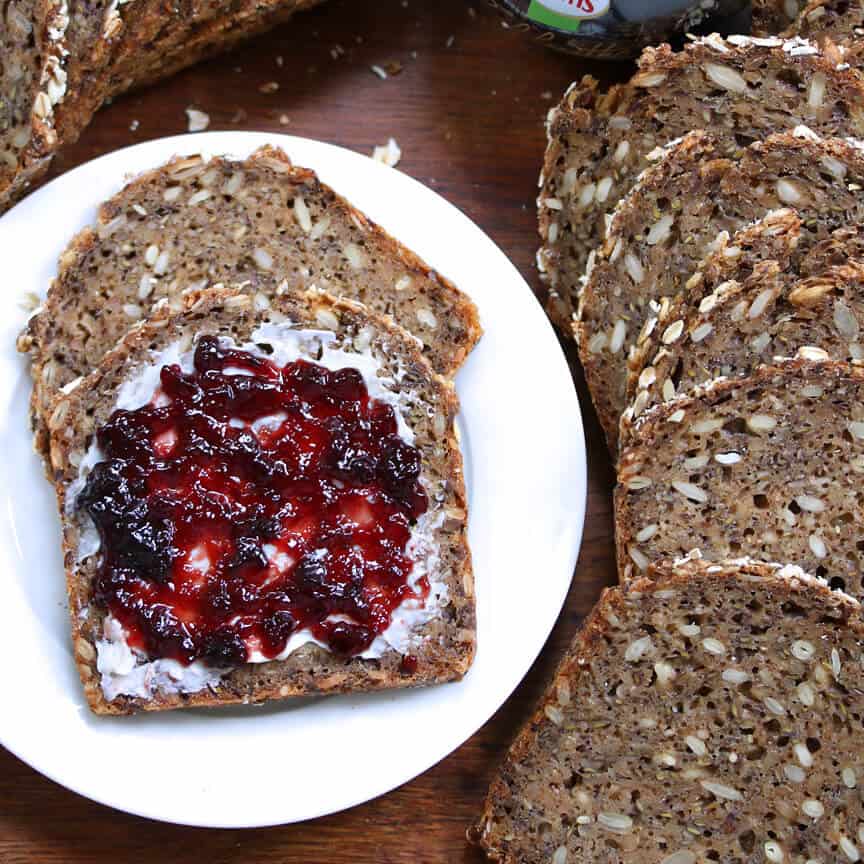
Authentic German Bread (Vollkornbrot)
Few things are better than a freshly baked loaf of bread slathered down with butter and some good jam. That’s true for crusty breads with fluffy interiors and the more hearty, dense breads that I also know and love from Europe. Here is a German bread that is beloved throughout Germany and is also widely enjoyed in Austria and Switzerland. It features a grain called Einkorn that is used throughout much of western Europe, but feel free to substitute other grains according to your preference.
Dense, chewy, packed with nutrition and full of flavor, this whole grain German brown bread (Vollkornbrot) is wonderful with your choice of butter, jam, Nutella, cheese, or cold cuts.
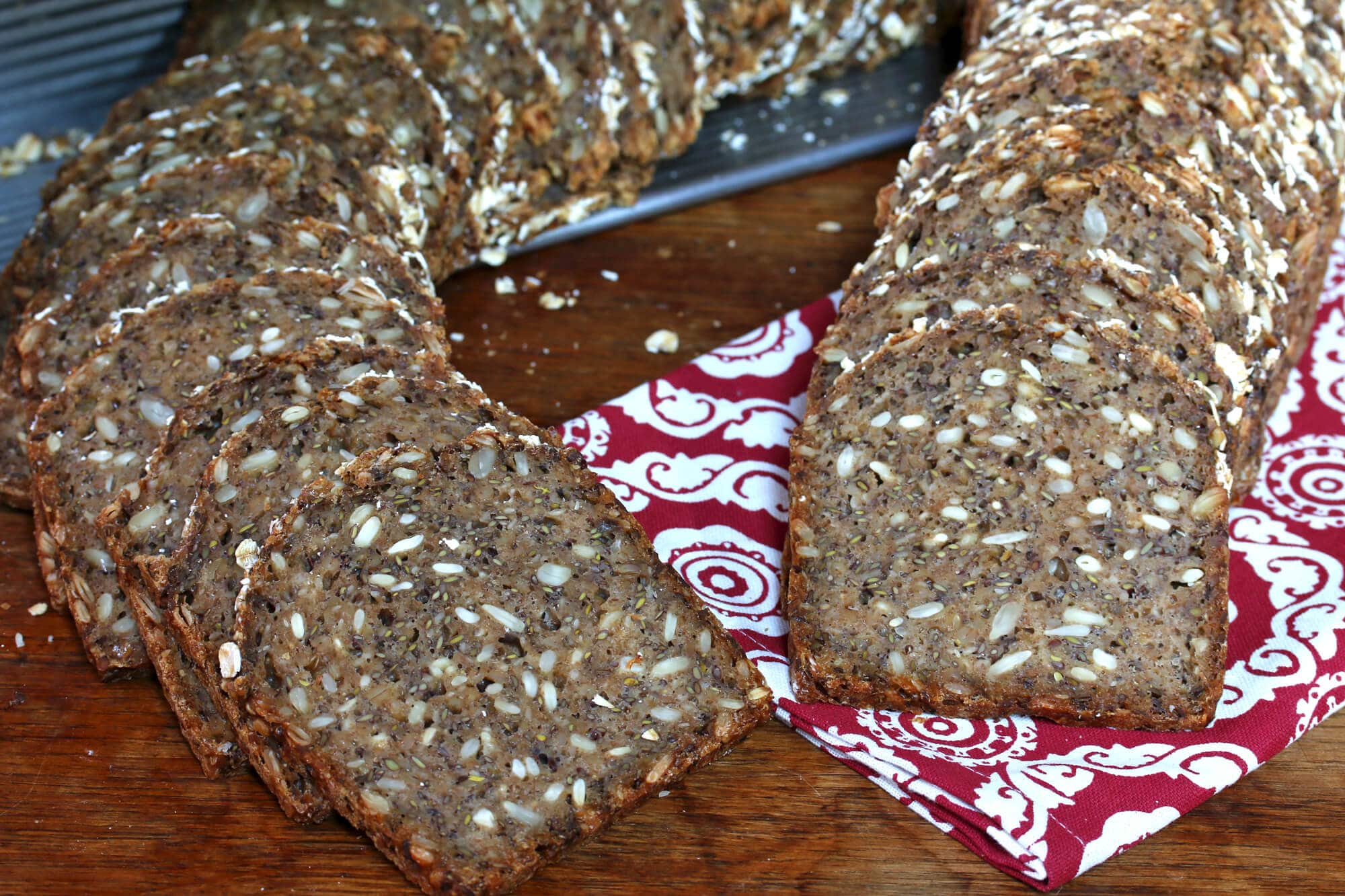
Have you heard of the grain einkorn before? Modern day wheat over the centuries has undergone a series of genetic changes for the purpose of increasing yield and gluten content. It’s almost unidentifiable compared to its ancestor (and my guess is that is why gluten issues are a more recent occurrence). Einkorn is the most ancient form of wheat on earth and hasn’t undergone these genetic changes. It is the purest form of wheat we have. You can purchase einkorn online HERE.
The advantages of einkorn: Most agree it tastes better than wheat and is much easier to digest, even easier than spelt. Compared to the gluten in modern day wheat, it contains a structurally different composition of gluten that the body is able to digest more easily. In fact, some people with gluten issues who have switched to einkorn have found that they’re able to tolerate and digest it with ease.
Even visually there’s a difference between wheat and einkorn. Though there are size variations within different types of wheat, generally most wheat (left) is longer in length than einkorn (right). Einkorn also has a deeper caramel color.

It’s unfortunate that as wonderful as Einkorn is, and common as Einkorn is in many places throughout western Europe, it’s almost unheard of here and very few places sell it. And for that reason it’s also much more expensive here in the U.S.. Hopefully that will change as it becomes more common. The same was true of spelt for a long time and though it’s still far less common than wheat here in the U.S. its price-point has gone down.
I buy all of my grains, including einkorn, in bulk. I take out what I need for a few weeks at a time and store the rest in a dark, cool place. It saves money that way and I have easy access to everything I need. And I LOVE being able to grind my own grains fresh as needed and make up my own fresh baking mixes!
My German-made KoMo grain mill is the pride and joy of my kitchen. German engineering at it’s best, the KoMo grain mill is simply awesome. You can grind your grains as fine or as coarsely as you like. With a 12-year warranty this thing is a work-horse and does a magnificent job. I use it nearly every day grinding my own flours, making cornmeal and a variety of mixes. I cannot recommend it highly enough.

This traditional German bread uses a combination of whole einkorn berries and ground einkorn flour. Whether you’re grinding your own grains or buying the flour already ground, you’re absolutely going to love the texture and flavor of this wonderfully hearty, rustic and thoroughly authentic German bread!
German Sourdough Bread
A couple of our readers have reported back about using sourdough starter instead of yeast. To make this a sourdough Vollkornbrot omit the yeast, add 200 grams of active sourdough starter, and reduce the flour by 100 grams and the water by 100 grams. Give the batter a full 24 hour ferment.
German Bread Recipe (Vollkornbrot)
Let’s get started!
Dissolve the yeast and sugar in the lukewarm water and let sit for 5-10 minutes until frothy. (See above if you prefer to use sourdough starter.)
Place all of the dry ingredients in the bowl of a stand mixer. (You can do this by hand if you prefer.)
NOTE: I personally don’t pre-soak the whole or cracked grain berries and let my batter ferment for a full 24 hours which softens the berries. Depending on the age of the grains you’re using they may require a pre-soaking in order to be adequately soft. If you wish you can pre-soak the grains overnight (pour hot water over them and let them sit) and then thoroughly drain for an hour or so.

Add the yeast mixture along with the buttermilk and beer. Knead on the bread setting (#2) for 10 minutes.
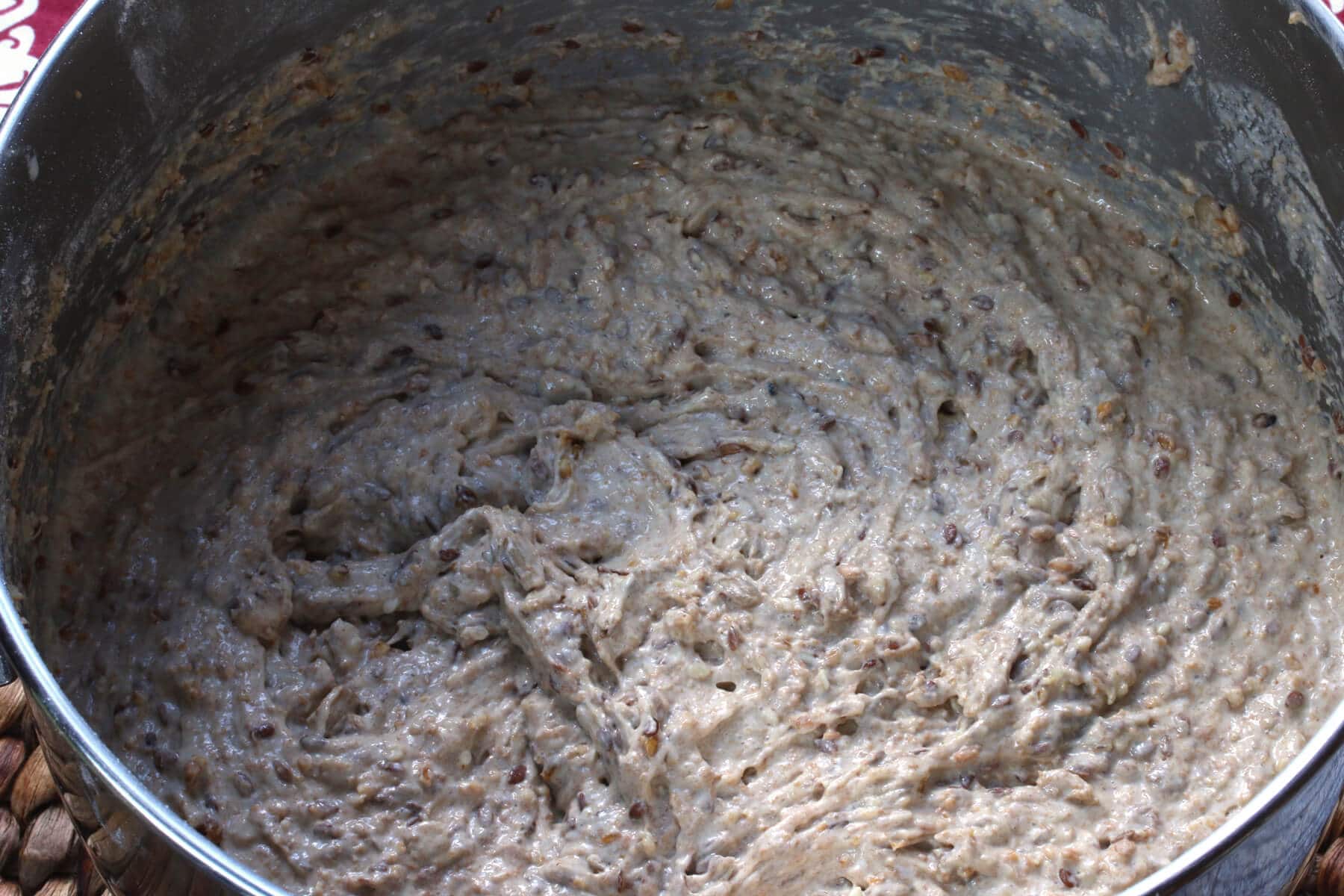
Scoop the mixture into a non-reactive bowl, cover loosely with plastic wrap and let it sit at room temperature for at least 8 hours, preferably longer, up to 24 hours (the longer the better for the whole grain berries to soften and for heightened sourdough properties. If you’re letting it sit for less than 24 hours, presoak the grains overnight in advance and drain thoroughly). Also, the longer it ferments the more liquid will be absorbed so less chances of a moist center after baking.
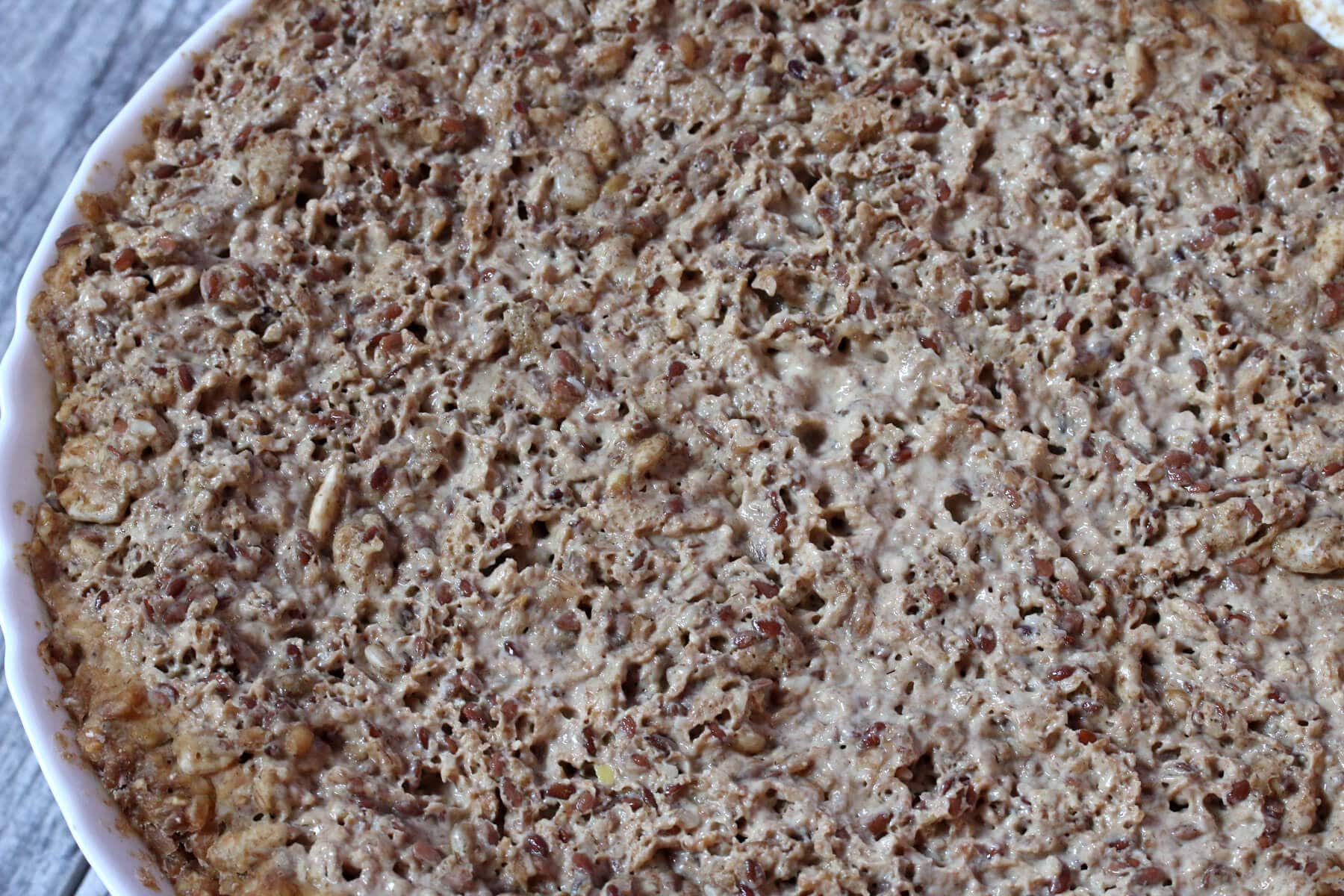
The mixture will be thick and gooey but will not resemble typical bread dough.
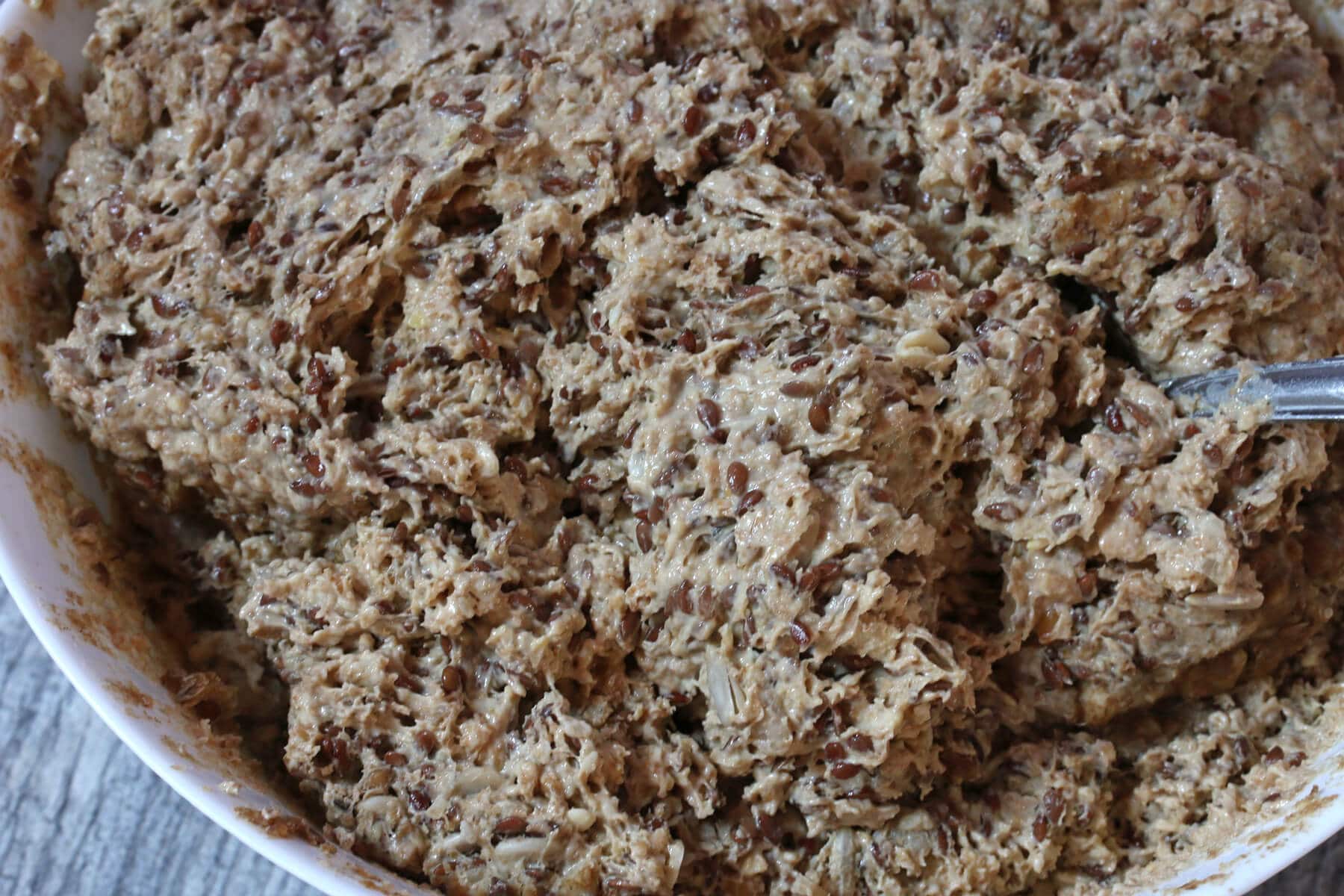
Scoop the mixture into a generously buttered Pullman Loaf Pan and smooth the top so it’s even.
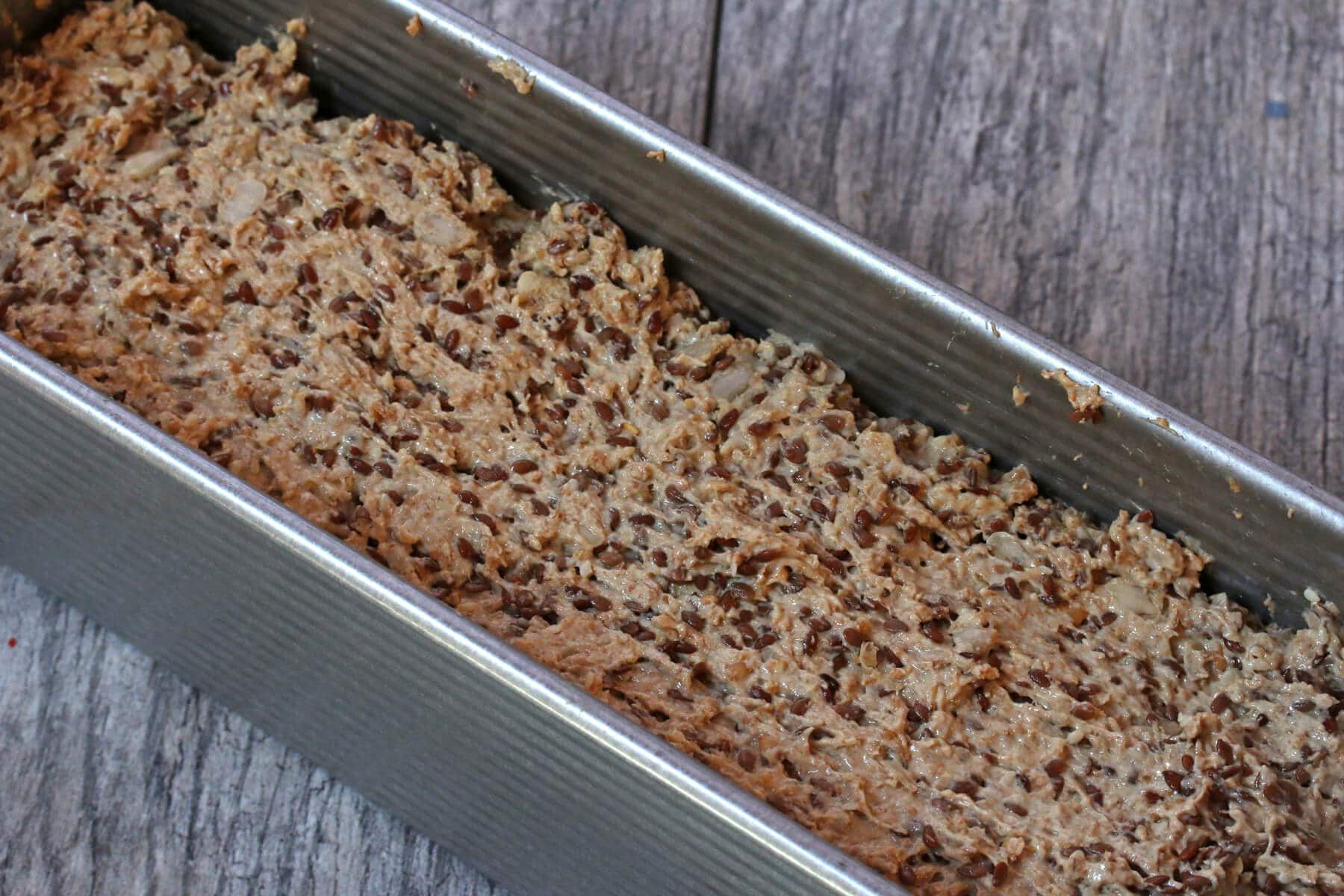
Baking this bread in a Pullman loaf pan yields those nice small, square slices of bread. But it also helps ensure that the center of the bread is fully cooked. Plus, when I’m making other breads that rise a lot, the Pullman has a top on it that slides shut to keep the bread compact (this Einkornbrot doesn’t rise a lot during baking so I don’t bother putting the lid on for it). It’s also the loaf pan that is used to make the famous French pain de mie bread. I like to use it for a lot of my heartier European style breads.
Sprinkle the top with rolled oats.
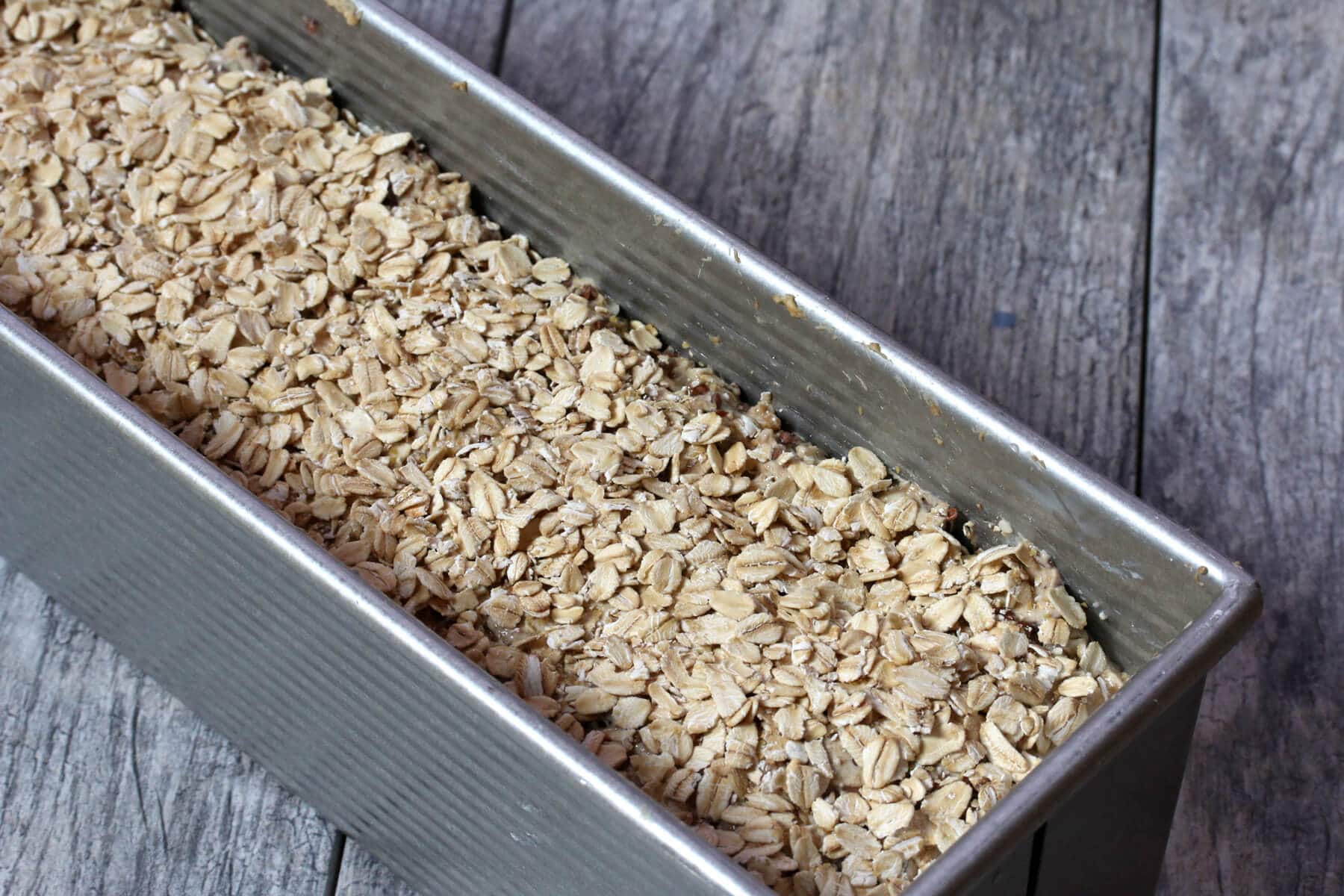
In an oven preheated to 350 degrees F, bake it on the middle rack for 100-120 minutes or until the center is done.
For best and most accurate results, use an instant read thermometer and aim for an internal temperature of 205-210 degrees F.
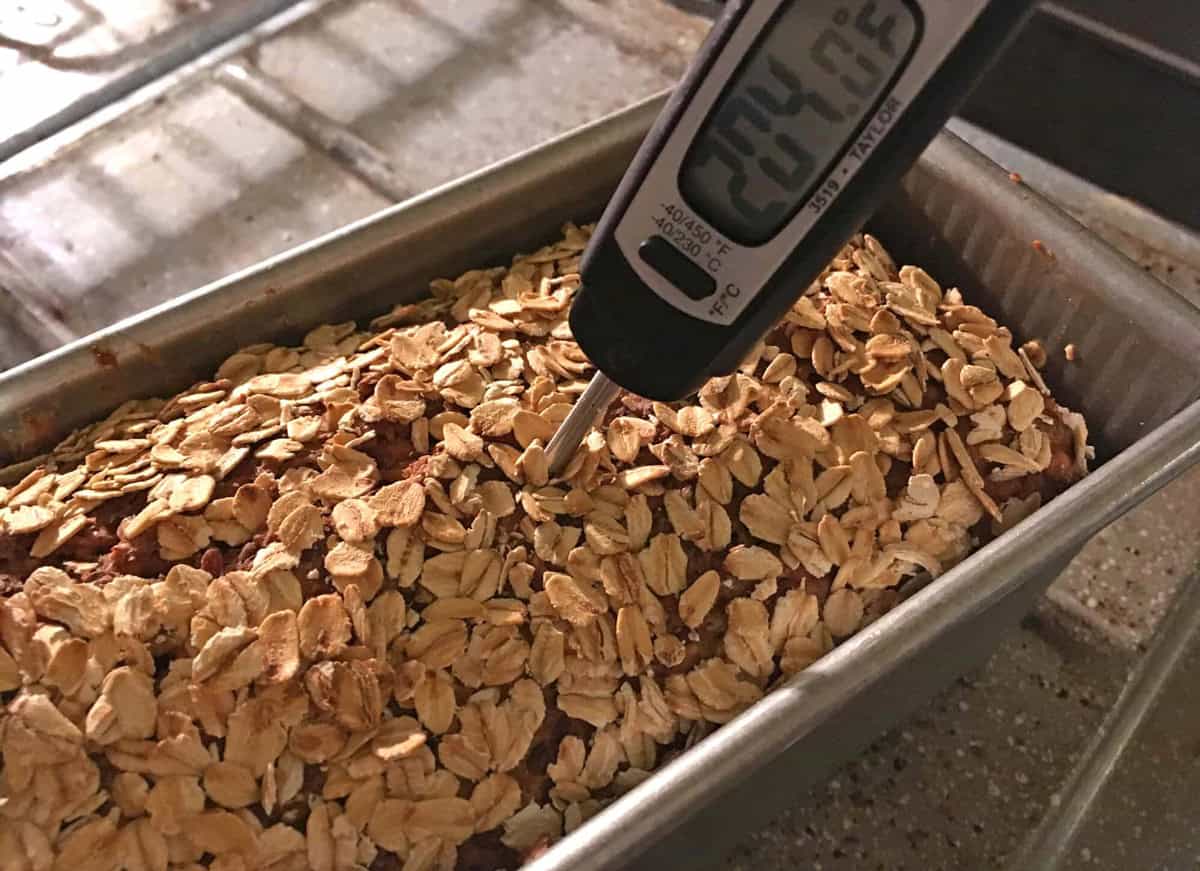
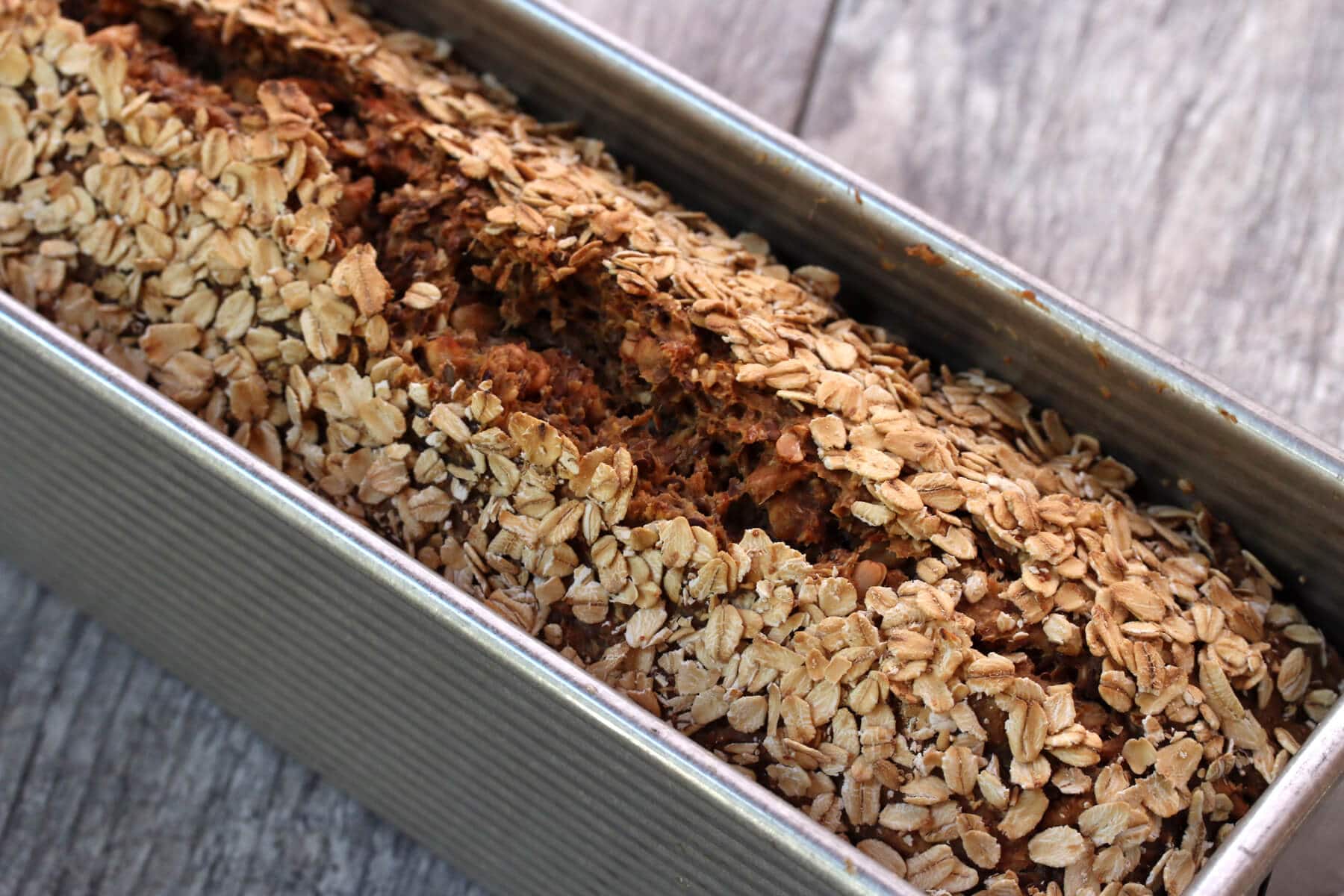
Let is sit in the pan for 5 minutes before removing it, then let it cool completely on a wire rack.
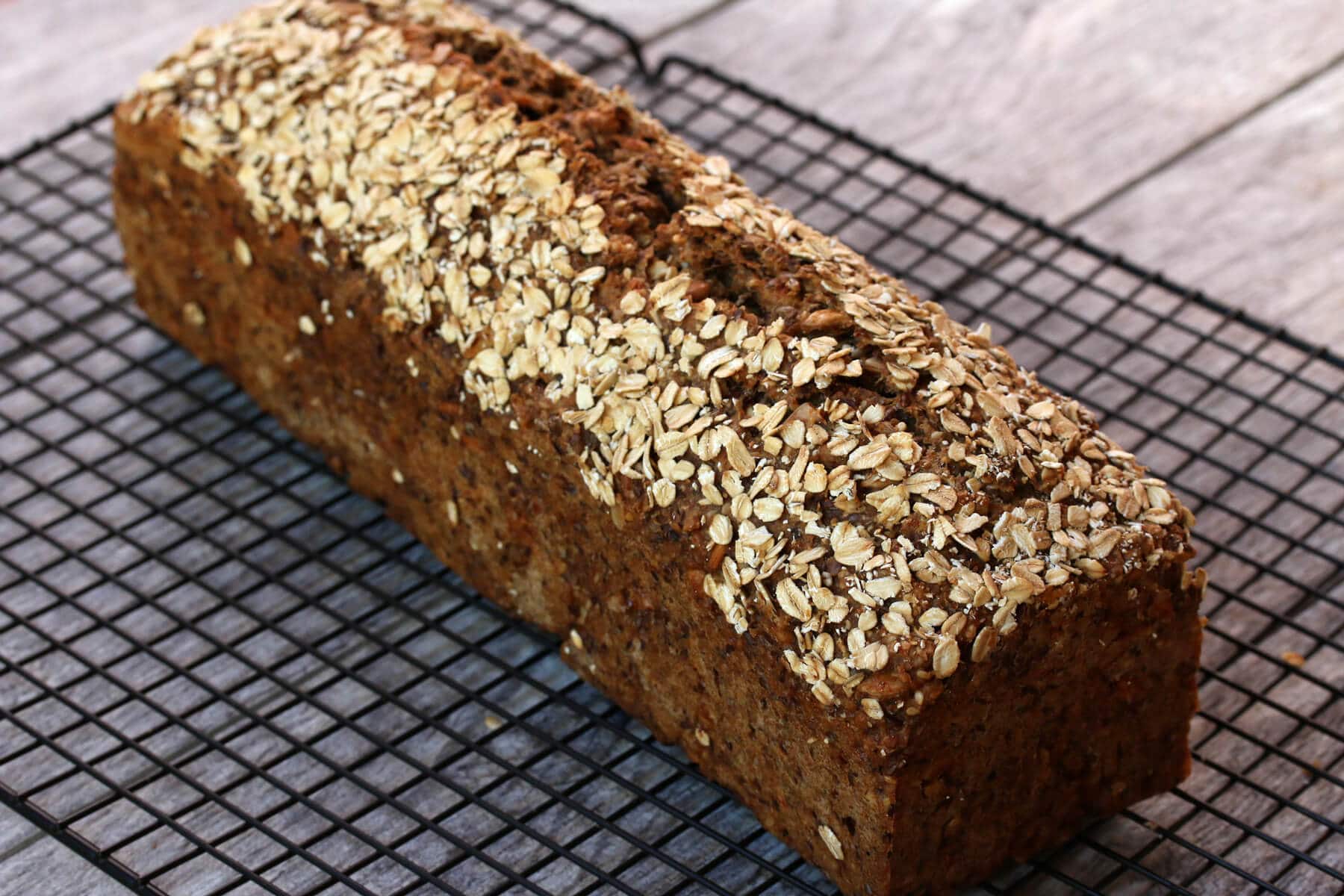
Once cooled you can slice the entire loaf in advance or slice as needed.
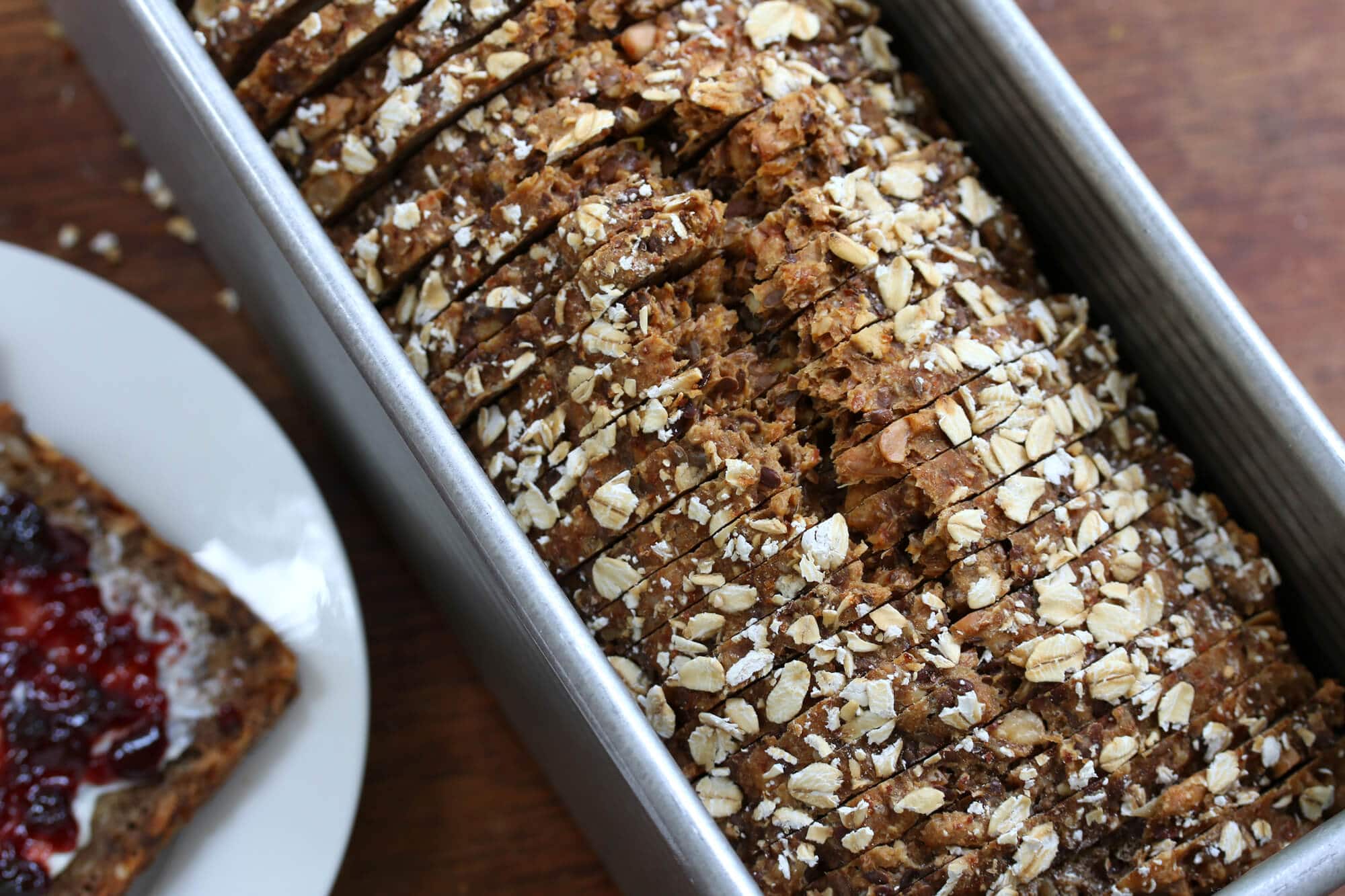
We have a decades-old Hobart commercial slicer that we picked up on Craigslist years ago. I used to be the manager of a delicatessen in England and Hobart is the gold standard in food slicers. In fact, the very same model that we have is on display at the Smithsonian!
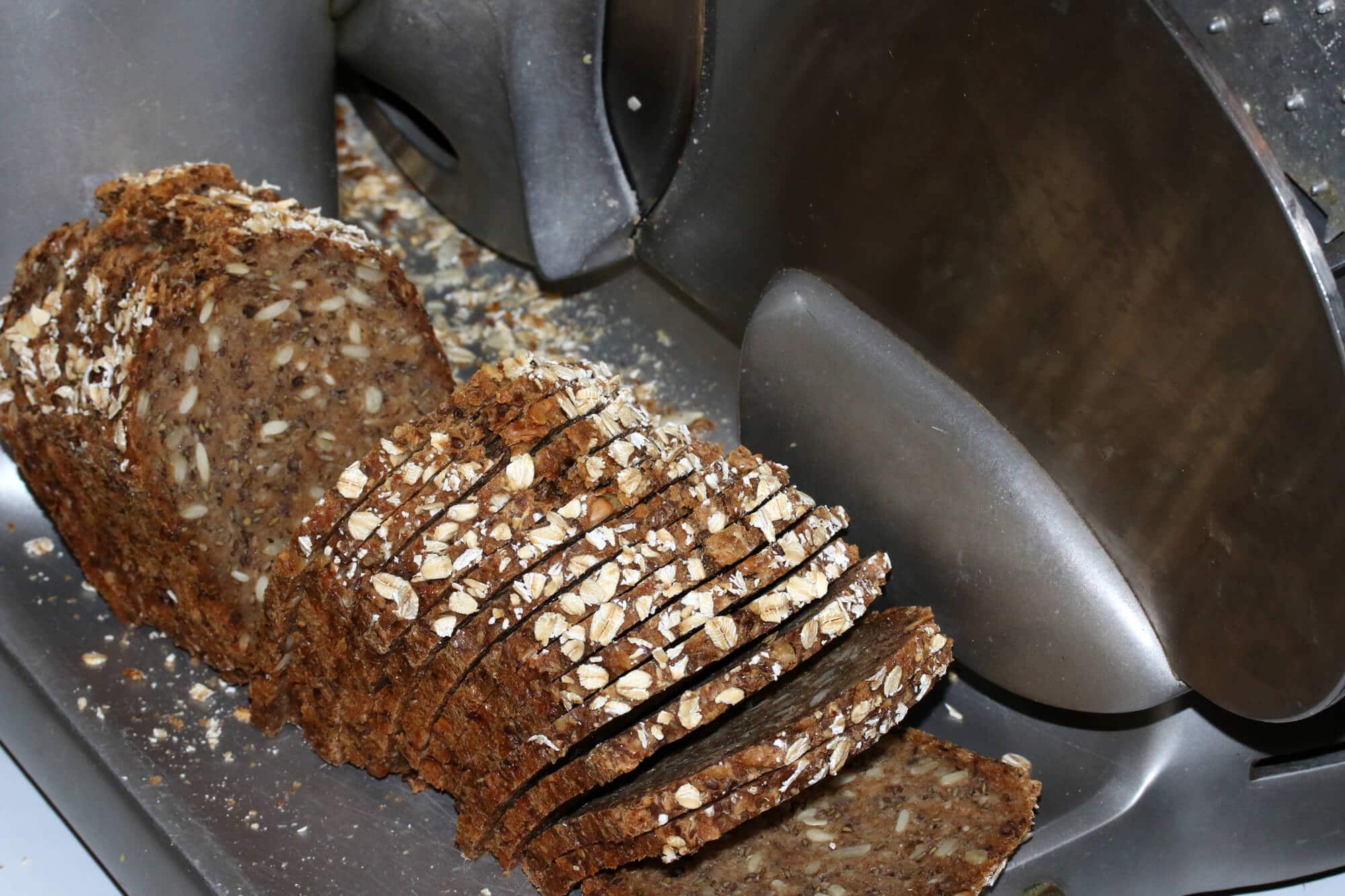
I realize we got lucky and most of you aren’t going to find a good-priced Hobart on Craigslist, but there are other good slicers on the market that are vastly cheaper and do the job. Chef’s Choice Slicers are consistently ranked at the top. I haven’t personally tried one, but they get excellent reviews. Having a good slicer to get clean, thin slices of bread that look like something you bought at a professional bakery is really nice. Plus, whenever I find chunks of cooked ham, turkey or cheese on sale I get those and slice them myself – it’s much cheaper than buying them at the deli.
At the very least you’ll need an excellent bread knife and for that my favorite knife, hands down, is the Cutco 9 3/4″ Slicer. It glides smoothly through bread and meat like no other.
Enjoy!
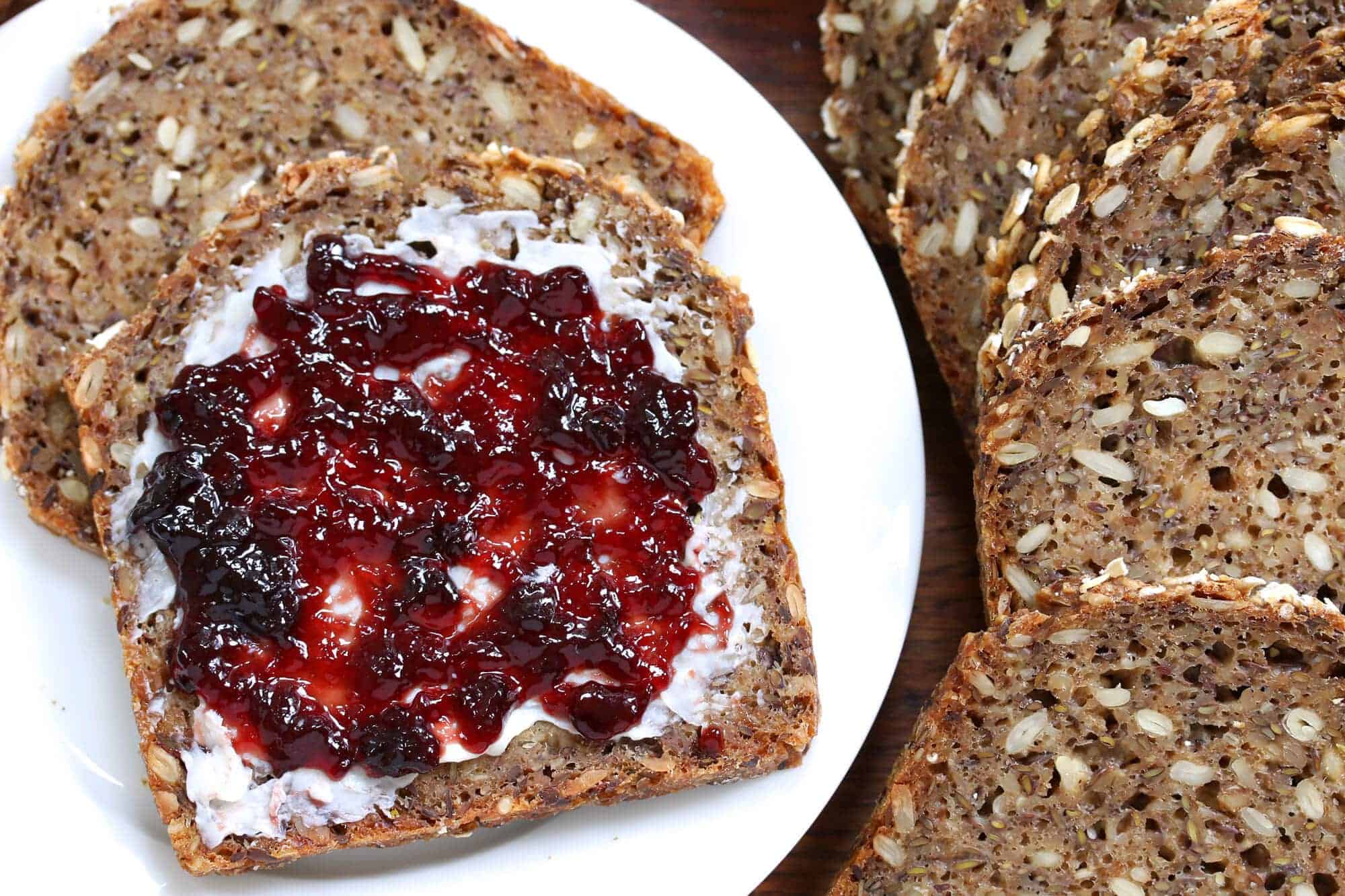
For more delicious bread from around the world be sure to try my:
- Lavash
- Injera
- Dosa
- Sourdough Naan
- Danish Rye Bread
- Crumpets
- Olive Rosemary Focaccia
- Skillet Cornbread
Save This Recipe
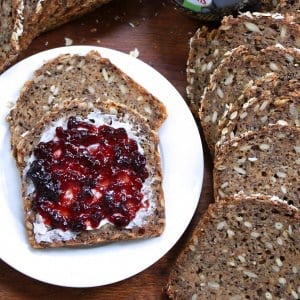
German Bread (Authentic Vollkornbrot)
Ingredients
- 4 1/2 cups einkorn flour (you can also use whole wheat, spelt, rye or combination)
- 1/2 cup whole einkorn berries , or wheat, spelt or rye berries (***See NOTE about soaking)
- 1 3/4 cups cracked einkorn berries , or wheat, spelt, rye (**See NOTE about cracking the grains **See NOTE about soaking)
- 1 cup whole flax seeds
- 1 1/2 cups sunflower seeds
- 1/4 cup sesame seeds
- 3 teaspoons salt
- 2 teaspoons dry active yeast ** see Note for sourdough substitution
- 2 tablespoons sugar , optional but recommended
- 2 cups lukewarm water
- 2 cups buttermilk , at room temperature
- 1 cup mild beer (optional, for a maltier flavor) , at room temperature (can substitute water or buttermilk instead)
- Rolled oats for sprinkling
Instructions
- Dissolve the yeast and sugar in the lukewarm water and let it sit for 5-10 minutes until frothy.
- Combine all of the dry ingredients in the bowl of a stand mixer. (You can do this by hand if you prefer.) Then add the yeast mixture along with the buttermilk and beer. Attach the dough hook and knead on the bread setting (#2) for 10 minutes. Scoop the batter into a large non-reactive bowl, cover loosely with plastic wrap, and let it sit at room temperature for at least 8 hours, preferably longer, up to 24 hours (the longer the better for the whole grain berries to soften and for heightened sourdough properties. Also the longer it ferments the more liquid will be absorbed so less chances of a moist center after baking.)
- Preheat the oven to 350 degrees F.
- Scoop the batter (it will be thick and gooey but not like regular bread dough) into a generously buttered 13x4x4 Pullman loaf pan and smooth the top to even it out. Sprinkle with oats. (Note: Baking this bread in a Pullman loaf pan yields those nice small, square slices of bread. But it also helps ensure that the center of the bread is fully cooked.) I always bake this without the lid on.
- Bake on the middle rack for 100-120 minutes or until the center is done. For best and most accurate results use an instant read thermometer and aim for 210 degrees F. Let the bread sit in the pan for 5 minutes before removing it, then let it cool completely on a wire rack before slicing it. To get clean, professional slices I highly recommend using a bread slicer.
Notes
- How to “crack” the whole berries: I use my grain mill to crack them by putting it on the coarsest setting. Another option is if you have a Vitamix and use the dry container – pulse the whole berries a few times until you get coarse pieces of einkorn. A powerful food processor will likewise do the job. Alternatively you can also place the whole berries in a ziplock bag and use a heavy object to pound them to break them up.
- Soaking the Grains: I personally don’t pre-soak the whole or cracked grain berries and just let my batter ferment for a full 24 hours which softens the berries, and I’ve always had great results. However, depending on the age of the grains you’re using (even if you just bought them they may have sat in the store or warehouse for a long time) they may require a pre-soaking in order to be adequately soft. If you wish you can pre-soak the grains overnight (pour hot water over them and let them sit) and then thoroughly draining.
- **Sourdough Substitution: To make this a sourdough Vollkornbrot omit the yeast, add 200 grams of active sourdough starter, and reduce the flour by 100 grams and the water by 100 grams. Give the batter a full 24 hour ferment.
Nutrition
Originally published on The Daring Gourmet December 11, 2019



















I had a similar problem when I made this recipe. The middle was raw even when I tried to cook it 30 minutes longer. I used regular loaf pans too. Is the Pullman loaf pan a requirement for this recipe? Are the einkorn berries cookies or dry? This bread looks so delicious I really want a loaf to come out. Thanks!
Hi Misha, yes, the Pullman is a must because it’s long and skinny and the heat can penetrate it more fully and evenly. It’s either that or you could try dividing the dough between two smaller loaf pans. The einkorn berries are dry, not pre-cooked (you can also use regular wheat berries). I know it’s a pain to have to buy the extra Pullman loaf pan, but if you can swing it I really recommend it – you’ll also really love the shape and size of the slices!
Thank you for the recipe.
I purchased a pullman pan (what a difference it made) I did soak the whole berries over night and let the batter sit for 6 hours before baking. I used 1/3 each of rye and red spring wheat berries (whole), next time will try to grind the wheat berries a little. I also put molasses instead of sugar. It turned out very good. But, it was moist.
How long do you wait before putting them in bags for the freezer.
Thank you so much for sharing. I bet that you didn’t expect to have so many questions, when you posted the recipe!!
Wonderful, Judith, I’m glad you enjoyed it, thank you! Questions are always welcome :) I usually pre-slice the bread before freezing it, that way I can just take out however many slices I need at a time. I haven’t had the problem with it being moist though. I guess in the case of this particular batch I would slice it and let the slices sit single-layer on the counter for a while to dry a bit and then freeze it. If it’s still a little moist I’d recommend putting a little piece of parchment paper between each slice to prevent them from freezing together – that way you can easily remove a slice or two at a time.
I have ordered the Pullman 13 x 4 and I will report back when I have used it :)
I’m impressed by your determination, Rene! I’m sorry the bread has failed you three times, but I’ve got my fingers crossed that my theory about the loaf pan is correct. Yes, please let us know how it goes the next time with the Pullman pan!
The loaf pan came yesterday and I baked a Vollkornbrot today… The pan seems to make every bit of difference. It came out perfect! Thanks again for the recipe, I am so happy! Perfect timing too :)
YES!!! I’m so glad we got to the root of the problem and that you can now turn out one perfect loaf after the other. Thanks so much for the feedback, Rene, and I’m so glad your determination paid off. Happy baking! :)
Thanks again for the recipe. It’s already a huge hit around here ;) I also bought the Magic loaf pan and I will next try the Danish Rugbrød. Will let you know!
I just checked, my loaf pan in 9.5″ x 5.33″ x 3″
I have to admit, I did not think it would make a big difference which loaf pan I use. I only have a generic one from Safeway but I already thought it may have something to do with the density in the form.
So, for this bread you use Pullman but for the other you use the Magic? Or would they both work in either?
Yes, for this one I use the Pullman pan because it’s a larger quantity of dough. Because the Pullman is a skinnier/narrower loaf pan, the heat from the oven is able to penetrate and properly cook the center of the bread. That is the likely culprit here in your raw-centered bread – too much dough in too small of a pan.
I have now tried it a third time with less liquid but the bread comes still out wet on the inside. I have no idea what I am doing wrong here :/
Hi Rene, can you elaborate on what you mean by “wet”? This type of bread is not like the spongy dry stuff; it’s supposed to be dense and somewhat moist. So I’m trying to determine if what you mean by wet is the dense/moist consistency it’s supposed to have.
Hi Kimberly,
Thanks for your reply. The first time the inside was raw. The second time I used less liquid overall. I live in Hawaii so I thought the humidity got to it. I now measured the inside temperature with a probe. It reached 199°F so I thought excellent but upon slicing it I found I be way too moist still. I understand it’s not a fluffy bread but it can’t even be cut properly.. I just don’t know what I am doing wrong..
I noticed somebody (you?) posted the same recipe under Danish Rugbrod with rye flour. Here it measure 4 1/2 cups but the rogbrod only gets 3 1/4 cups. Could either recipe be off?
Hi Rene, no the ratio of wet to dry ingredients is very similar between the two breads and I’ve gotten great feedback about both from readers who have made them. I’ve also made them both several times myself, so I’m confident that the ratios are correct. The only thing I can think of is perhaps it has something to do with the bread pan you’re using. Are you using the long, narrow Pullman loaf pan or are you using something different? Standard bread pans are wider and that would explain why the center of the bread isn’t fully cooked.
Do you cook the whole grain berries before adding. I am thinking that it would be too hard to chew, if they were not cooked.
No, no cooking necessary. By the time the wet bread batter has sat for several hours and then baked the berries will be softened.
Definitely going to try this. Thank you, Kimberly. As usual, you have given me another one of your great recipes to attempt. I have the slicer and the USA Pan Pullman pan…. Going online now to see about the grinder and the bulk flour/grains you’ve suggested. Have you tried L’Epicerie website for flour? I order their T-65 for my authentic French baguettes instead of the T-55 (German type 550) now.
LOL… I just found an older Pullman pan in the back of the closet that I picked up many moons ago at E.Dehillerin’s.
Thank you again for your post, I really enjoy them.
P.S., What flavour of Zentis is that? Waldfrucht, johannisbeere or heidelbeere marmaladen/konfituren?
Hi Joel! I haven’t tried the flours from L’Epicerie but they have a really nice selection. What I’ve been doing more and more is just experimenting on my own with my KoMo grain mill. I love the spectrum of ultra coarse to ultra fine and how easy it is to adjust the settings. Since getting my KoMo I hardly ever buy flour anymore. My pantry is stocked with dozens of different whole grains that I grind into flour myself whenever I need it. What I should do though is buy some T-65 (thanks for the suggestion) as a point of reference so I can work on getting my own ground version just right. Much cheaper that way and I also just love being able to grind my own flour fresh. E.Dehillerin – I’ll bet you picked up some other treasures as well? The Zentis jam – I think it was Schwarzer Kirsch.